Hughes’s 50th
High School Reunion
Ojai, California
October 6,
2007
PREFACE
To
any classmate who
might read this, let me say right up front that I don’t believe I have
much
credibility as a
class or community historian. I’ve never been to a previous
reunion, and I don’t
have a sense of continuity nor a grasp of class/community history that
others own. I left Ojai in 1958 after a year at Ventura JC
to continue college in Ohio and then moved on to Massachusetts,
Michigan, Ohio, and now Colorado, and I haven’t been back to town except for
one
brief visit. I have never kept in touch with any of you, which
I regret, especially after meeting you again and learning your
rich
life stories. I feel more of an outsider than many others who attended.
All I can do is look back with my memories and find new meanings
comparing the past with the present.
A LOOK IN
MY REAR VIEW MIRROR
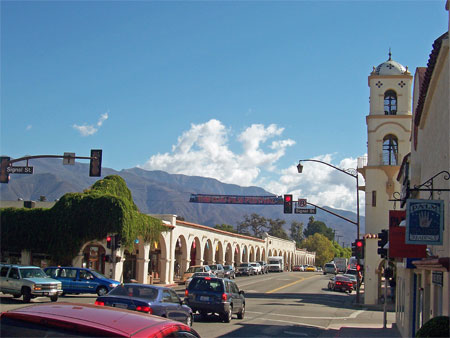 For those who are unfamiliar with the southern
California landscape, Nordhoff Union High
School is in Ojai, a small picture postcard
town nestled comfortably in a southern California valley about two
hours north of
Los Angeles and 20 miles from Ventura’s Pacific Coast. It is still home
to
orange groves, artists and eccentrics, Theosophists and free thinkers,
and about 8,500 folks who believe there is not a better place on this
planet to live.
For those who are unfamiliar with the southern
California landscape, Nordhoff Union High
School is in Ojai, a small picture postcard
town nestled comfortably in a southern California valley about two
hours north of
Los Angeles and 20 miles from Ventura’s Pacific Coast. It is still home
to
orange groves, artists and eccentrics, Theosophists and free thinkers,
and about 8,500 folks who believe there is not a better place on this
planet to live.
The the town was incorporated as
Nordhoff in the 1870s, named for noted writer Charles Nordhoff of Mutiny on the Bounty fame and a
prominent booster of southern California’s weather and life style. The
high school was named after the town. However, during WW I the town was
summarily renamed Ojai, a Chumash word that probably means moon, though local lore has it that
it means nest. The name
change was accomplished either through the efforts of a local
businessman, or an edict by then Senator James D. Phelan, or because of
prevalent anti-German sentiment—or all three. In any case, the high
school retained the name Nordhoff. Edward Drummond
Libbey, who made his fortune in glass in Toledo, Ohio, fell in love
with the Ojai
Valley in the 1920s and gave his vision (and money) to the town’s
development. He
was responsible for the trademark arcade, post office, the city park
that bears his name, and much more. For a complete history of Ojai, I
recommend The
Ojai Valley: An
Illustrated History by Patricia L. Fry (Matilija Press, 1983),
or David Mason’s shorter but interesting “About Ojai.”
My family moved to Ojai from
Santa Paula in 1951 and I started junior high on the same campus as the
high school. I never knew why my folks chose Ojai, but I was always
grateful. My father still had to drive to
work in Ventura and Los Angeles, just as he did from Santa Paula. Maybe
my folks saw
opportunities in Ojai that my sisters and I didn’t see. It was,
however, a place we came to appreciate. I
still call it home, though I was born elsewhere and lived in Ojai only
seven years.
During my years at Nordhoff, I
listened to Mr. Polski read Ernie Pyle
during 7th grade math and Mr. Owens read Chaucer in the original. I
diagrammed countless complex sentences assigned by Miss Harris and
translated
Caesar’s Ga(u)llic Wars
for Mr. Neal. I concocted “touch paper” in Mr. Thompson’s chemistry lab
that exploded the following period in English. It gave Ruth Simmons
quite a start sitting next to me, to say nothing of Miss Harris.

I played some sport year almost
year round. I
was never a star, but I managed to make the teams. I did have two
memorable sports moments I cherish: I scored all 14 points in a JV
football game (two TDs and two PATs, thanks to Bill Williams’ passing),
and I hit a grand slam home
run
(probably with help from some careless play in the opposing team’s
outfield)
against
arch rival Villanova. I played a lot of handball at noon hour with
Bobby Cordero, Dick Kerr, and Del Garst, who were really good; I shot
pool with John Krabiel on many Sunday
afternoons; and I played badminton well enough to win intramural
medals and later teach it in college.
I cried over Darla’s grave in Our Town, the senior play, edited
the high school
newspaper, and helped Cynthia Quam get the yearbook right. I played in
the all-county band three years on trombone, tuba, and baritone, and
I sang with “The Cherries” at school assemblies and dances. I had a
car, went steady with two terrific girls, and lost my class ring at a
summer institute at
Northwestern University. I still don't know what happened to my
letterman’s sweater. I was elected Vice-President of the Santa
Barbara-Ventura Interscholastic Council (SBVIC) my senior year and
drove to meetings with Shirley Abbey, who was elected Secretary. After
school, I wrote high school sports for The Ojai (the town paper)
and for the Los Angeles Examiner,
and I cleaned swimming pools at two motels in town.
I didn’t graduate with many “life
skills,” nor do I remember worrying about it. I wasn’t particularly
well prepared for college—let alone life. I hadn’t learn to write well
(though I could diagram Faulknerian prose with the best of them) or
read critically until I got to
college, where I also learned to love history. I avoided the sciences
in spite of four successful years of math and two sciences, and I
can’t
speak a foreign language fluently. 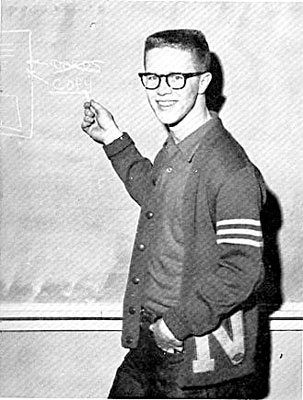
I did develop an interest in
music and
sufficient skills so that for many years I sang with the Toledo
Symphony Chorale. I still play trombone in a brass
band on the 4th of July, and I perform with a local Celtic bluegrass
group on
guitar and pennywhistle.
I even soloed on the bagpipes for our 40th wedding anniversary
party. Mr. Kaiser must take credit for some of that. Performing in
school plays
probably prepared me for 20 years as a professional storyteller, though
that would come much later.
Like most of the class
of 1957, I found high school, for the most part,
great fun. I actually looked forward to going each day. Yes, I had
class obligations and homework, but they came with the package. Sitting
next to Freida Lee didn’t hurt either. Having
a good time at school (and outside) must have been
part of the
ethic of the 1950s. When I
left Ojai, I encountered a different, more serious, challenging world
for which I had
little experience and few skills. Graduation from high school was, as
the cliché goes, a commencement, a beginning. It was certainly
not a culmination. For me it was a starting point. I had to get on with
life and I felt quite
ill prepared.
What I did have throughout high
school, though it
has taken me a long time to realize the truth of it, was a circle of
friends who supported, encouraged, protected, cheered, and criticized
each other every day. Many of our teachers were, in their ways, part of
that circle, though we would never confess it. Perhaps the same
was true for the community as a whole (“the village”), though I was
never aware of it.
These were the thoughts and
recollections that made my 50th reunion something I looked forward to.
If I had
reservations about attending a reunion—and I did—it was
because I believed that
meeting my past would spoil my memories.
I should not
have worried.
A WARM-UP
IN THE BAY AREA
Judy and I planned an extensive road trip
to
Ojai in our RV, camping through the northern Rockies and down the
Pacific
coast.
We had a great visit with my sister and her family in Spokane. Along
the way, Cynthia emailed an invitation to visit her on our way to Ojai.
She knew
we would be coming close to Mountain View
where she lives and we thought the visit would give us a good deal of
time to get
reacquainted after 50 years. We said we’d love to, and we arrived the
weekend before the reunion.
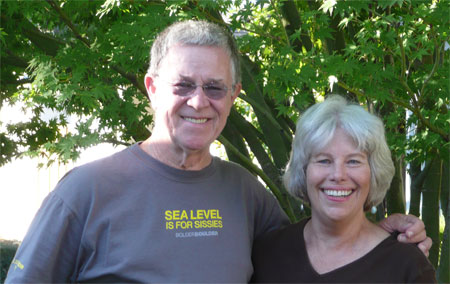
Cynthia was the perfect hostess.
She and
Judy warmed to each other right away, she loved Sophie and Bella,
and she immediately made us feel right at
home. Remember, this was after half a century had passed since we had
seen
or talked with each other! She had some plans, yet waited to see what
we might like to do.
She invited Darla (Grainger)
Belshe to have dinner with us and the four
of us talked for hours, or at least until Darla felt she should make
the return trip over the mountains to her home in Santa Cruz. It was a
wonderful evening. We never
had the luxury again of the time and quiet atmosphere to learn about
our
lives since high school. (Reunion parties and
dinners tend to be louder than old folks’ ears can stand, and
conversations often don’t have the chance to develop in depth.)
I was
delighted and relieved that both Cynthia and Darla had changed very
little since high
school. Not only would I recognize them at any time, anywhere, but
their personalities seem to have remained pretty much the same. Maybe I
haven’t changed all that much either.
The next day we walked through
the Stanford campus and, later, we met her granddaughter, Haleigh, who
took a
liking to the
dogs also. Cynthia also let us get a head start on reading the booklet
of reunion biographies, which Darla compiled and Cynthia had printed to
take to Ojai. It was fascinating reading and a great help to me to
catch up on
50 years in a hurry.
The list of names on the
first page of the 24 classmates
who had died before the reunion was sobering. I didn’t know most of
them had passed away, nor did I know why or when. I felt way out of
the loop. Some, I knew, had died during high
school, some shortly after graduation, some just in the past year. Some
were
killed, others were victims of disease or accidents. All were
tragedies.
All too soon. Too soon.
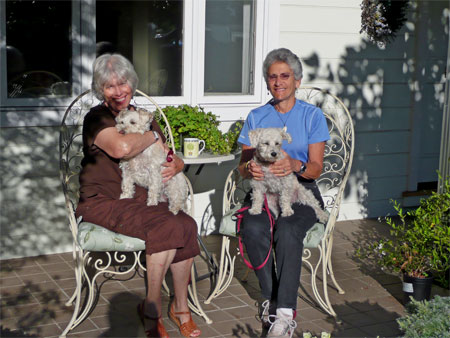
Each of the 68 biographies showed
the rich variety of
lives that each of us had made for ourselves:
•Some of
my classmates have become nationally prominent, like Academy
Award
winner Freida (Lee) Sanders, or Bill Rambo, whose life was almost cut
down
by an airplane propeller but survived to become an award-winning USGS
geophysicist.
•Many
of my classmates—too many—spoke of dealing with
divorce(s) or the death of a spouse, or other family tragedy. Yet each
went on with their lives, finding strength and meaning in their
children and grandchildren. Some hinted at disappointments, lives that
had not turned out
not as they might have chosen, yet they are still content because of
family,
friends, car, career, good health, faith.
•Most of the class spoke of
successful
careers (a few are even still working!), attachment to their children
and grandchildren,
and the pleasures of retirement.
•Some
biographies were short—simple, all too brief statements devoid of
elaboration or detail, leaving me to wonder what the realities of their
lives really
were, yet respecting the implied privacy.
•Some
classmates sent biographies but could not attend. I missed reconnecting
with several friends I had been looking forward to spending time with.
I have their addresses and emails and will plan to talk/write/meet them
in the future.
I was glad to have had a chance
to learn the backgrounds of the folks I’d be meeting in a few days for
the first
time in half a century.
REDISCOVERING OJAI
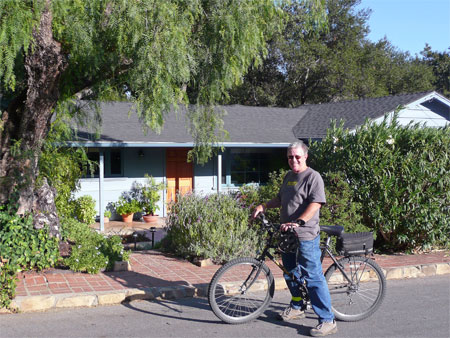
Back
in August I had called Ruthie Simmons Jones when she was working the
front desk at the Hummingbird Inn to
see if we could park our RV in their parking lot during the reunion. I
tried not to let on who I was, but she had me pegged within five
seconds. It was a pleasure to talk with her, even for a short time. She
said we would be welcome to park there and that she would work it out
with
the owner/manager. However, Ruthie went in for back surgery in
September and while she was recovering, new owners took over the motel.
At the last minute, they didn’t think an RV in their parking lot would
be a good idea. Cynthia came to our rescue by putting us in touch with
classmate Sharron Reitzel Fletcher and her husband, Charles. Sharron
knew the owner of the Woolsey
House B&B and she and Charles were planning
to park their RV on the property. She put in a kind word with Anna, the
owner, and we were invited to park at the beautiful historic
Woolsey House for the four days we would be in town. Water and electric
hook-ups
could be arranged, and please feel free to use the swimming pool. No,
dogs are not a problem. What generosity! Thank you so much, Sharron and
Anna, for your help in getting us out of a good-sized hole. You have no
idea how good that made us feel.
When Judy and I go RVing we don’t tow a
car, but we always travel with bicycles. Ojai is a perfect size to get
around
town on bikes and see most everything. We easily found my old house on
Mallory
Way across from the Masonic Hall that’s now an apartment building or
very large house. My grandparents built their retirement home just two
doors north of our house in the early 50s. Both have been remodeled and
look much nicer than I remember. The motel at the end of the street
where I worked as a pool cleaner evolved into apartments and the
swimming pool has been filled in. Bart’s Books still flourishes
a
couple of blocks away, and the tiny cottages behind our house where
Miss Harris and Mr. Neal lived (separately, of course) are even smaller
than I remember them—hardly bigger than a suite at a Fairfield Inn. We
couldn’t find the house my dad built for my aunt and uncle. It was, I
think, on Aliso Street, but the area’s changed too much to be sure.

In the heart of town is Edward Libbey’s
arcade that houses a variety of wonderful shops, including classmate
David
Mason’s Village Florist
which he’s owned for over 40 years. We did what visitors to town have
done for years: we shopped the arcade stores in shady
comfort for art, for gifts, for whatever turned our heads. Just walking
through the arcade is a pleasure. Edward Libbey got it right nearly a
hundred years ago.
We discovered the running/bike path
that connects Ojai with Ventura. What a marvelous addition to the
valley! Judy took her morning runs along it and I rode my bike at the
same time. I also rode down to Camp Comfort, which always seemed miles
from town. It’s quite modern and paved over from what it was 50 years
ago—and not as far from town as I had remembered. In fact, town seems
to have shrunk to a much more manageable size than my teenage memory
permits. The one thing that has
grown is the Country Club where I
waited tables 50 years ago. It has expanded the number of
buildings
and its facilities, but the golf course remains a thing of beauty.
We rode to the old high school building
that now has “Matilija School” in bright letters next to the entrance.
There are new buildings of course, but gone is Jack Polski’s math
classroom with the tall windows in the back that opened onto a porch
that Ronnie Holloway and I might use as an escape route while Ernie was
reporting on WW II. Sadly, the handball courts
that served many of us so well for so many years are gone. What do the
kids do
now with their lunch hours I wonder? Do they even have lunch hours
anymore?
One afternoon, Cynthia picked us up for
a tour of the east end of the valley, the scenic part where
orange groves and avocados still flourish, where interesting eclectic
houses are tucked hidden away down secluded roads, where we used to
drag race, and where the Thacher
School is no longer “for boys” but remains an excellent boarding prep
school that has gone co-ed. The highlight of our tour was a visit to
Meditation Mount that overlooks the valley.
It was built in 1971, thirteen years after I left. There are several buildings for
classes or group meditation with
wonderful views. The outdoor park has a serene atmosphere for
just being quiet, meditating, or, as demonstrated by a couple who got
there before we did, a good place for some gentle necking. On the way
back, Cynthia drove pretty fast over the treacherous dip in Grand
Avenue. That brought back memories!
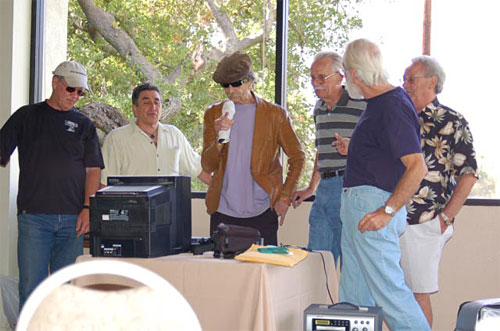
The Hummingbird Inn is conveniently
located across from Soule Park Golf Course
Clubhouse where the reunion
would be held. Every day we would ride toward town in the morning and
stop in at the Hummingbird for impromptu reunions with those who
were staying there. We were having a mini-reunion with two non-Nordhoff
couples who stayed there, along with several other members of the class
of ’57, so it was a logical place to find out what was happening that
day.
Since The Cherries were scheduled
to
perform at the reunion, the six of us agreed it would be prudent to
have at least one rehearsal (left to
right: me, Bobby
Baron, Bill Williams who threw the passes, Don Zogg, Paul Downey who
was originally our accompanist, and Nelson Russell). Bobby had sent
each of us during the
summer a CD of what we would perform and he showed up with
commemorative T-shirts, a sound system complete with karaoke music
tracks, his sock over the microphone, and lyrics flashing on
a
small TV screen. No need for live music—just follow the bouncing ball.
Sounds easy enough. Our first rehearsal was devoted to setting up the
sound system and then, after a run through of the songs, we discovered
that a second rehearsal would be mandatory. Rehearsals improved from
one to the next, yet we were not sure we would be ready. If we had
taken ourselves seriously, our mood would have been
desperate. Since we were practicing the 1950s ethic of “Have a good
time,” getting together like that was great fun. If the ultimate
performance
was not quite up to our 1957 standards when girls swooned and the other
guys listened enviously, well…we had a good time. And I’m told, by a
modestly partisan informer, most of the audience did too.
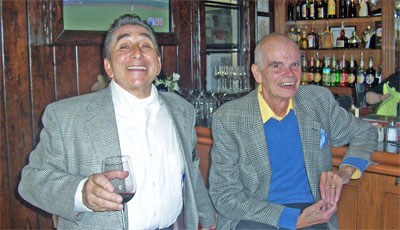 BOBBY THROWS A
PARTY
BOBBY THROWS A
PARTY
The day before the reunion, Bobby
(seen here with classmate David Mason) hosted a
pre-reunion cocktail party at what used to be a biker’s roadhouse (or
something like that) west of town. But Bodee’s in the past 50 years has
gone upscale and the setting was genteel enough for late afternoon
cocktails
and cabernets.
While not everyone came, those
who
did had an extra two or three hours to talk with old friends and catch
up on
grandkids, careers, trips, health problems, retirement issues,
long term health insurance, and other things that old people talk about
when they get
together. There was even some “Do you remember the time…?”
conversations, but not as many as I would have thought. The focus was
more on getting reacquainted with each other. It was noisy and it was
crowded; people laughed a lot, no one left early, and there were no
fights
or arguments, and no one got very drunk. There was a good deal of
bragging, the truth was stretched a
little here and there, and I saw lots of hugging and back slapping. All
in
all, it was a really
fine party. It set the tone for the main event the next night. You did
good, Bobby. I’m glad we came early.
THE MAIN
EVENT
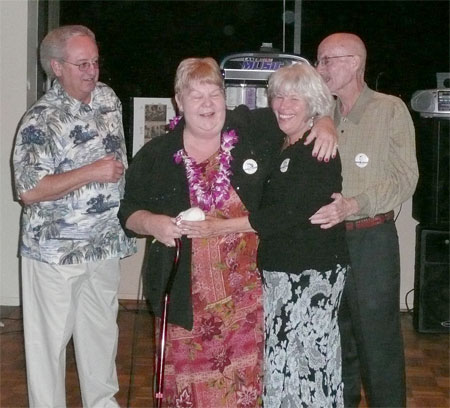
Soule Golf Course is a fine public
course that was built sometime in the past 50 years. I wasn’t around
when it was developed. I only remember a lot of empty space on the east
side of town. The clubhouse had a room that was
just right for the 100+ alumni and their spouses.
Nelson, who was student body
president in 1957, and senior class president Jerry Todd were masters
of
ceremonies. Nelson had some jokes prepared and Jerry offered a few
appreciative remarks about those who had planned the reunion. Evidently
there were some who felt more should be said and more individuals to be
recognized, which led to unscheduled speakers taking the mike
from them and rounding out the presentations. Ruthie and Cynthia
engaged in a friendly but determined game of
tug of war for the microphone.
In addition to printing the
written biographies, the planning
committee wisely decided to make buttons for each of us to wear that
had our
name in large print and our senior class picture. Not only did the
buttons help when we all got together, but I found them helpful when I
got home and tried to identify faces that were not immediately
recognizable. I looked in the photos at the button the person was
wearing and could read the more familiar face from 50 years ago.
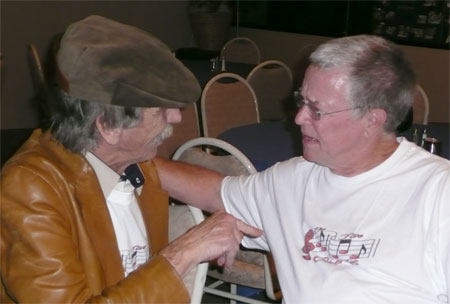 A highlight of the evening for me was Bill Williams
reading his poetry, rich in imagery and references to our lives in the
1950s, and dedicated to classmates who had died. His words evoked
strong emotions that brought us all to our
feet. Maybe even Mr. Owens stood up and joined in the standing ovation
Bill received. His words managed to touch the hearts of each
of us who listened:
A highlight of the evening for me was Bill Williams
reading his poetry, rich in imagery and references to our lives in the
1950s, and dedicated to classmates who had died. His words evoked
strong emotions that brought us all to our
feet. Maybe even Mr. Owens stood up and joined in the standing ovation
Bill received. His words managed to touch the hearts of each
of us who listened:
“I don’t mean to be maudlin just facing the truth
57s ain’t gettin’ less long in the tooth.
Some of us here may never meet again,
Let’s cherish this evening and enjoy fond friends.”
While I don’t remember Bill as an
aspiring writer—his biography points to military service, a close
brush with professional prizefighting, sales, and driving a cab—I’ve
long ceased to be surprised that anyone from any background has within
him or her ideas, images, and feelings that can be best expressed
through poetry. No formal training is necessary, no degree
required, only a passion for self-expression. Bill certainly has that
passion and he bowled over all of us that evening. I glad I had a
chance before we left to tell him how
impressed I was with what he had written—and with his passing in that
JV
football game I remember so well.
Mr. Owens and Mr. Kaiser, two of our
teachers were introduced and each had a chance to say whatever was on
their minds. They chose not to chastise us one last time for being
“Yahoos” (Mr. Owens’ frequently used literary allusion to slow witted
people Gulliver
met in his travels). Instead, both were gracious and spoke of their
lives since retirement. Mr. Owens took the opportunity to offer a verse
of his own—something to do with an outhouse in Alaska?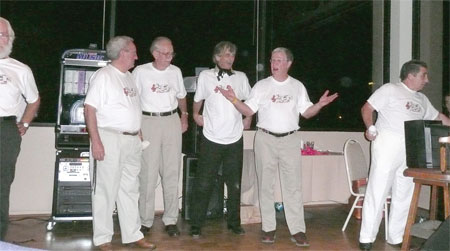
The dinner buffet took longer to set up
than expected and Nelson had the unenviable task of stretching his
jokes and patter longer than he’d anticipated. But about the time he
seemed to run dry, we were called for
dinner.
After dinner The Cherries performed
seven songs that were hits of the 1950s, ones we might have performed
during our senior year. We started with Little Darlin’, our signature song
from 1957. Apparently our classmates remembered
and tossed panties and bras at us before we were even half
finished. Just part of the show: all articles were
clean, some had been ironed. Bobby took the lead on Why do Fools Fall in Love? and Tears on My Pillow, Bill did a 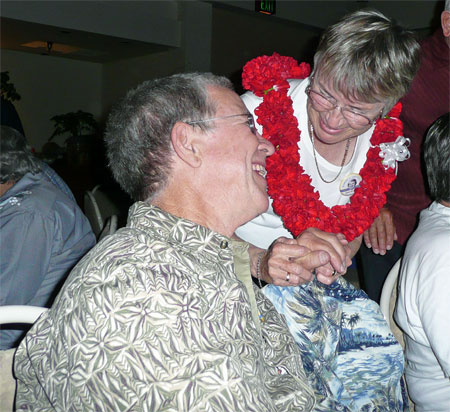 classic
impression of the Big Bopper’s Chantilly
Lace, Nelson carried the load (and the tune) with Sea Cruise, and Paul finished off
the set with Great Pretender
and Unchained Melody solo
while I backed up on the piano. Somewhere during the performance,
Mr. Kaiser wandered up from his seat nearby to complain about
something—his
hearing aid, I believe.
classic
impression of the Big Bopper’s Chantilly
Lace, Nelson carried the load (and the tune) with Sea Cruise, and Paul finished off
the set with Great Pretender
and Unchained Melody solo
while I backed up on the piano. Somewhere during the performance,
Mr. Kaiser wandered up from his seat nearby to complain about
something—his
hearing aid, I believe.
The photo of us in T-shirts above
is the only image I have of the
entire group on stage that evening—and it’s not very satisfactory. If anyone has a better photo of the group
on stage, I’d
love to get it from you. Write or email and I’ll substitute it for the
one above.
Our performance closed the evening. It
was all over too soon. Some last minute conversations and the hall
cleared. The chance for a whole class picture vanished, a photo op
we’ll never have again. No one thought to get The Cherries together for
one last formal group photo, just in case we would need one for an
album cover. Several of us have sent our
pictures to Cynthia, who is hosting a free
photo site where nearly 200
snaps are available for downloading and making prints. I’d guess
everyone who was there is included in at least two or three photos. I’m
sure more can be added at any time if you have not contributed to
the collection. Just contact Cynthia and she’ll take care of it.
EPILOG
Two
years ago Judy was one of three women
who did most of
the work
planning for her 45th reunion in Pennsylvania.
I watched how hard she worked for months to make her reunion a success. I hope Ruthie,
Cynthia, David (Mason), Darla, Bob, Lynne, David (Sparks)
and Del (and their spouses) feel they received the appreciation of the
class for
their planning. Thanks also to Bobby, not only for the ice-breaker at
Bodee’s, but also for
insisting that The Cherries
come out of retirement for one last performance. What a hoot! And Darla
deserves heaps
of praise for preparing the class
biographies
for publication. What a great job you all did!

 For those who are unfamiliar with the southern
California landscape, Nordhoff Union High
School is in Ojai, a small picture postcard
town nestled comfortably in a southern California valley about two
hours north of
Los Angeles and 20 miles from Ventura’s Pacific Coast. It is still home
to
orange groves, artists and eccentrics, Theosophists and free thinkers,
and about 8,500 folks who believe there is not a better place on this
planet to live.
For those who are unfamiliar with the southern
California landscape, Nordhoff Union High
School is in Ojai, a small picture postcard
town nestled comfortably in a southern California valley about two
hours north of
Los Angeles and 20 miles from Ventura’s Pacific Coast. It is still home
to
orange groves, artists and eccentrics, Theosophists and free thinkers,
and about 8,500 folks who believe there is not a better place on this
planet to live. 






 BOBBY THROWS A
PARTY
BOBBY THROWS A
PARTY
 A highlight of the evening for me was Bill Williams
reading his poetry, rich in imagery and references to our lives in the
1950s, and dedicated to classmates who had died. His words evoked
strong emotions that brought us all to our
feet. Maybe even Mr. Owens stood up and joined in the standing ovation
Bill received. His words managed to touch the hearts of each
of us who listened:
A highlight of the evening for me was Bill Williams
reading his poetry, rich in imagery and references to our lives in the
1950s, and dedicated to classmates who had died. His words evoked
strong emotions that brought us all to our
feet. Maybe even Mr. Owens stood up and joined in the standing ovation
Bill received. His words managed to touch the hearts of each
of us who listened: 
 classic
impression of the Big Bopper’s Chantilly
Lace, Nelson carried the load (and the tune) with Sea Cruise, and Paul finished off
the set with Great Pretender
and Unchained Melody solo
while I backed up on the piano. Somewhere during the performance,
Mr. Kaiser wandered up from his seat nearby to complain about
something—his
hearing aid, I believe.
classic
impression of the Big Bopper’s Chantilly
Lace, Nelson carried the load (and the tune) with Sea Cruise, and Paul finished off
the set with Great Pretender
and Unchained Melody solo
while I backed up on the piano. Somewhere during the performance,
Mr. Kaiser wandered up from his seat nearby to complain about
something—his
hearing aid, I believe.